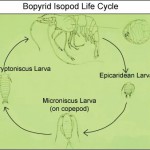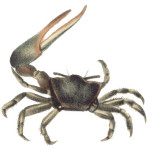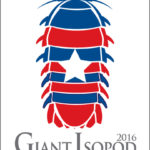
Bathynomus giganteus (Arthropoda: Crustacea: Isopoda: Cirolanidae)
You know those cute little roly-poly bugs you found under rocks as a kid? You poke at them and they curl up into a little ball? Well, magnify that times 1000, take away the functional role of the eyes, head to the deep-sea and you’ve got the Giant Isopod, Bathynomus giganteus!
Description Bathynomus giganteus was first discovered in fishermen’s nets in the Gulf of Mexico and was described as the type species of the genus by Alphonse Milne Edwards in 1879 (12). It is the largest known isopod, reaching lengths up to 50cm. That is about the length of small dog or cat! Most isopods only reach lengths between 1-5cm. They have a strong and thick exoskeleton and take on the general shape of your typical “flattened” isopod. B. giganteus has 7 pairs of pereopods, or legs, which are uniramous (meaning only one pair of legs per segment). The first pair of pereopods is modified into maxillipeds (literally “mouth feets”) that help move food to its 4 sets of jaws modified for cutting and tearing.
Physiology
Interestingly, they have a compound eye with over 3,500 facets (4). The eyes are overgrown by the exoskeleton and exposure to natural daylight causes irreversible damage to their photoreceptors (4). It isn’t clear whether these eyes have any function or just evolutionary remnants from a relatively young diversification (8), but they do not respond to the visible spectrum and have only low sensitivity to the ultraviolet spectrum at the 360nm wavelength (4). It is suggested that they rely mainly on chemoreception (4) and possibly mechanoreception (7) or to find prey items.
Isopods have hemocyanin for transport of oxygen, but in B. giganteus it also acts a major phenoloxidase (13). The hemocyanin protein of B. giganteus also has amino acid substitutions at the N-terminus that are more similar to primitive arthropods such as the chelicerates (sea spiders, horsesheoe crabs) and myriapods (centipedes & millpedes) (13).
Nutrition
Gut content analysis of B. giganteus show mostly fish fragments, as well cephalopod, caridean shrimp and galatheid crab remains (3). In smaller quantities, sponge fragments, other isopods, echinoderms, nematodes and tunicates have been found (1, 3). Unfortunately, large quantities of plastic were discovered in the guts of 3 specimens from north of the Yucatan Peninsula in the southern Gulf of Mexico (3). Most authors agree that B. giganteus is a scavenger (3, 5, 6), but some suggest it is also a facultative predator (3, 6). Specimens in aquaria have survived 8 weeks between feedings (5) and it speculated that this may be an adaptation for carrying its brood, which would be severely impacted by a full stomach (3). Further support for this hypothesis are the large quantities of lipid reserves in the hepatopancreas (14) and fat bodies (2) of this isopod. B. giganteus has also been collected from baited traps outside of methane seeps in the northern Gulf of Mexico (11). Stable carbon, nitrogen and sulfur isotope analyses confirm a detrital source of nutrition with some input from chemosynthetic sources, ranging from 0-45% (11).
Reproduction
Eggs of the giant isopod are also giant, up to 13mm diameter (6) and are brooded in a brood pouch above the stomach and internal organs (10). Females do not feed when brooding and seem to bury themselves in the sediment to reduce energy expenditure during brooding, which would insulate them and protect the brood and adults from predators. This unfortunately appears to make them more susceptible to trawls since brooding females have only been caught in trawls and not baited traps (1, 3). Juveniles of Bathynomus giganteus are called mancas and reach length up to 6cm. Mancas are characterized by the lack of the seventh pair of pereopods. The smallest sexual mature males and females reported are around 21cm (3) and 16.6cm (5), respectively. Individuals from the Gulf of Mexico show patterns of seasonal reproduction (3) and appear to release their brood between August and February (3), with low reproductive activity in the summer (1).
Ecology
Isopods apparently make good taxis as well! Several epibionts have been documented on the carapaces of B. giganteus including the barnacle Octolasmis aymonini, the gastropod Mitrella amphisella, serpulid polychaetes and hydrozoans (1, 3). Interestingly, Mitrella amphisella, from a family of carnivorous snails (Columbellidae), is found mainly on females and in the brood pouch (3). Not much is known about what types of organisms eat Bathynomus giganteus, but one paper reports a specimen in the gut contents of a tiger shark (3).
Biogeography
B. giganteus occurs at depths between 310-2140m (6), although in one rare case a single specimen was reported from 80m off the coast of Brazil (9). The giant isopod has a more or less global distribution. No one has studied to my knowledge the genetic connectivity between these isolated populations, but there is no doubt that further sampling should turn up more specimens from other areas of the world
Further Reading:
1. Barradas-Ortiz, C., P. Briones-Fourzan, and E. Lozano-Alvarez. 2003. Seasonal reproduction and feeding ecology of giant isopods Bathynomus giganteus from the continental slope of the Yucatan peninsula. Deep Sea Research Part I: Oceanographic Research Papers 50:495-513.
2. Biesiot, P. M., S. Y. Wang, H. M. Perry, and C. Trigg. 1999. Organic reserves in the midgut gland and fat body of the giant deep-sea isopod Bathynomus giganteus. Journal of Crustacean Biology 19:450-458.
3. Briones-Fourzán, P., and E. Lozano-Alvarez. 1991. Aspects of the biology of the giant isopod Bathynomus giganteus A. Milne Edwards, 1879 )Flabellifera: Cirolanidae), off the Yucatan Peninsula. Journal of Crustacean Biology 11:375-385.
4. Chamberlain, S. C., V. B. Meyer-Rochow, and W. P. Dossert. 1986. Morphology of the compound eye of the giant deep-sea isopod <I>Bathynomus giganteus</I>. Journal of Morphology 189:145-156.
5. Cocke, B. T. 1986. Deep-sea isopods in aquaria. Tropical Fish Hobbyist 35:48-52.
6. Holthuis, L. B., and W. R. Mikulka. 1972. Notes on the deep-sea isopods of the genus Bathynomus A. Milne Edwards, 1879. Bulletin of Marine Science 22:575-591.
7. Klages, M., S. Muyakshin, T. Soltwedel, and W. E. Arntz. 2002. Mechanoreception, a possible mechanism for food fall detection in deep-sea scavengers. Deep Sea Research Part I: Oceanographic Research Papers 49:143-155.
8. Kussakin, O. G. 1973. Peculiarities of the geographical and vertical distribution of marine isopods and the problem of deep-sea fauna origin. Marine Biology 23:19-23.
9. Lemos de Castro, A. 1978. Descricao de uma especie nova gigante do genero Bathynomus Milne-Edwards
do litoral brasileiro (Isopoda, Cirolanidae). Revista Brasileira de Biologia 38:37-44.
10. Lloyd, R. E. 1908. The internal anatomy of bathynomus giganteus, with a description of the sexually mature forms. Memoirs of the Indian Museum 1:81-102.
11. MacAvoy, S. E., R. S. Carney, C. R. Fisher, and S. A. Macko. 2002. Use of chemosynthetic biomass by large, mobile, benthic predators in the Gulf of Mexico. Marine Ecology Progress Series 225:65-78.
12. Milne-Edwards, A. 1879. On a gigantic isopod from the great depths of the sea. Annals and Magazine of Natural History 5:241-243.
13. Pless, D. D., M. B. Aguilar, A. Falcon, E. Lozano-Alvarez, and E. P. Heimer de la Cotera. 2003. Latent phenoloxidase activity and N-terminal amino acid sequence of hemocyanin from Bathynomus giganteus, a primitive crustacean. Archives of Biochemistry and Biophysics 409:402-410.
14. Steeves, H. R. I. 1969. Lipid contents of the hepatopancreas of the isopod Bathynomus giganteus A. Milne Edwards, 1879. Crustaceana 16:135-138.






Cocke, B. T. 1986. Deep-sea isopods in aquaria. Tropical Fish Hobbyist 35:48-52.
This is fantastic. Do any aquariums keep Bathynomus now? I’d love a copy of the paper.
Is there some sort of taboo regarding mention of the obvious superficial resemblance of these modern critters and Trilobites (seems like I’ve seen a few articles here an there about marine isopods but there nearly never any mention of trilobites…)? Or is it just considered so obvious as to be not worth mentioning?
(Do they likely share a common ancestor, or is there any possibility that the modern deep-sea isopods are actually descendants of a trilobite population?)
Hi Peter,
You should have that journal in your library. I can scan it in and send it to you. I think Cocke was a student of someone at Texas A&M, maybe Wicksten.
Good questions SMC. Whereas trilobites and these isopods are the same phylum (Arthropoda) they are in different subphylum. Isopods are in the Crustacea and trilobites are currently in the Chelicerates (sea spiders, true spiders, scorpions, and horseshoe crabs). There are several specific differences in anatomy between the two. For example the appendages of trilobites are relatively undifferentiated compared to isopods.
But what do they taste like?
PS Happy birthday Kevin.
Along the lines of SMC and McClain, here is a fun website on trilobite imposters: http://www.trilobites.info/triloimposters.htm
Several lines of evidence seem to suggest that Bathynomus is more derived than a living fossil, especially the morphology of the eyes.
Thanks RPM, I’m just glad to make through the year of death. Of course not doing drugs or owning guns helps somewhat. Hopefully my 29th revolution around the sun will be successful as well (b-day was apr 2 btw, 56 min. from april fools day)
Better late than never. We linked to this post for futher reading.
Thanks!
Lovely critters! I’m afraid the Baltic is too shallow & brackish to be much of an isopod habitat. We have to make do with Saduria entomon, which does have its own scaly charm.
I wonder if they make you eat them on Fear Factor…
Man that is an interesting and pretty isopod!
Not to mention big!
Anybody interested in the eyes of Bathynomus giganteus’ smaller relatives, look up:
Magnus Lindstrom et al 1991 “Exposure to bright light has little effect on eye sensitivity and ultrastructure of Saduria entomon”. Zool. Sci. 8: 653-663 (Saduria entomon is the small ‘relative’ in the baltic Sea)
Meyer-Rochow, V.B. 1982 “The divided eye of the isopod Glyptonotus antarcticus: effects of unilateral dark adaptation and temperature elevation”. Proceedings of the Royal Society, London, B215: 433-450
(Glyptonotus is a fist-sized isopod from Antarctica – which does not taste very good!)
Wow. Where can I get a giant isopod exoskeleton?
check it on Flickr
Man, That would be some huge!!!! lobster dinner. I wonder if they taste good???
They look related to Horseshoe Crabs
regarding flavor, if you want and you live in the mid-west you could taste one of it’s relatives. Go get a handfull of those pill bugs I used to squish on a suburban chicago sidewalk and give then a try. If I am not mistaken those little bugs are also isopods. They do have anatomical similarities. I have always wondered if lobster meat is just like bug meat but bigger. Because if those big bugs I see people eat on tv taste like lobster now I know why they are always smiling when they take a bite, they are laughing at us who turn pale at the propect of eating bugs.
This is so fantastic. No other words come to my mind. Very Interesting. Getting my kids to learn about this as well. They are are in awe. Thank You!
Somewhere between a Lobster and a cockroach
Wow! These would be great for a Horror Film!! Someone make it please!
I remember watching twilight Zone when I was a little girl back when T.V. was black and white and they had and isopods on it as a monster that attached it self to people,I did not know there was a creature like that .I wonder how many times they have used this creature in movies and shows since T.V.has been invented. DeBra
Everyone seems to wonder what they taste like. I wonder if they taste like lobster. I don’t think I’d be scared to eat it because it resembles lobster tail anyway. Think of all the variety of dishes you could fix it in!
I believe they are eaten in Asia!
I’ve always loved the sound effects on the sped-up portion of this clip: http://www.youtube.com/watch?v=xeOSXtBCY30
It sounds like my kids at the dinner table.
They look like the independence day invaders.
Hey, are the eyes really non-functional? I don’t have full-text access to Chamberlain 1986 that’s cited, but here’s the abstract:
http://www.ncbi.nlm.nih.gov/pubmed/3746916
By my reading, all of their animals were exposed to daylight, and daylight apparently caused permanent damage to photoreceptor structures. The data for “do not respond to the visible spectrum”, was that measured on eyes that had been destroyed by light? The abstract sure seems to imply that.
And for that matter, if the eyes can be damaged like that, it means that obviously this “overgrown by the exoskeleton” doesn’t stop light, and they contain highly light-sensitive elements. I’m betting they function at proper light levels.